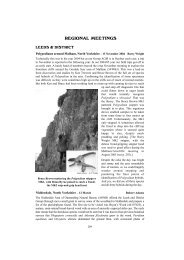Full Contents as pdf File - Natural History Museum
Full Contents as pdf File - Natural History Museum
Full Contents as pdf File - Natural History Museum
Create successful ePaper yourself
Turn your PDF publications into a flip-book with our unique Google optimized e-Paper software.
SEATTLE, WASHINGTON STATE, USA – 15-25 July<br />
Introduction Pat Acock<br />
Sue and Harry Olsen first suggested the idea of this trip to Martin Rickard in the 1980s. It<br />
w<strong>as</strong> somehow put off in the busy scheduling of the Society until Sue and Harry were<br />
visiting the UK in 1999. Matt Busby wanted an illustrated talk to go with the annual fern<br />
show at Warwick and Sue and Harry agreed to travel down the M6 from The Lake District<br />
and they gave a memorable lecture on ‘The Best of the West’. This, and Alan Ogden’s<br />
frequent illustrated talks on the New World, whetted appetites for such a meeting.<br />
It w<strong>as</strong> sad that at the earliest process of planning Harry should have been so tragically taken<br />
from us. It w<strong>as</strong> with our very grateful thanks that Sue agreed to continue the planning and it<br />
is a testimony to her great courage and fortitude that we could embark on such a unique and<br />
excellently planned foray.<br />
Miller Botanical Garden, Seattle (Tuesday) Pat Acock<br />
Many of us met over breakf<strong>as</strong>t and planned various ways to spend the morning before<br />
meeting together at 1pm. At this time we informally met with our host, Sue Olsen, and a<br />
number of her Hardy Fern Foundation colleagues who were to lead the various elements of<br />
The Tour. We were handed an enormous file <strong>as</strong>sembled by Michelle Bundy, full of useful<br />
information and details so that we could prepare ourselves for each day.<br />
At 3.30 we left in a range of ‘people carriers’ for The Miller Botanical Garden. Sue had<br />
done well to secure this trip for the party <strong>as</strong> the garden limits the total number of visitors<br />
each year. Richie Steffen, who oversees the garden and library, gave us a brief history of<br />
how Elisabeth Miller set up this garden just north of the Seattle City Limits on a bluff above<br />
Puget Sound. She cleared some of the native conifers and gradually established collections<br />
of hollies, ericaceous plants and ferns. Self-taught, she started to experiment with new<br />
plants, displaying them and eventually sharing information with others. This h<strong>as</strong> been the<br />
focus of the garden ever since she died and left it to be run by a charitable trust. I w<strong>as</strong><br />
especially interested in the large Met<strong>as</strong>equoia glyptostroboides, which w<strong>as</strong> one of the first<br />
planted in the west. Ferns included many hardy species and a number of British cultivars;<br />
one of my favourites w<strong>as</strong> a large Dryopteris x complexa.<br />
In the evening we dined at the water’s edge in Ivar’s Salmon House on the local speciality,<br />
smoked salmon. Here we were officially welcomed and were able to really get to know<br />
each other in a relaxing situation. Following dinner, Bors Vesterby gave us a lecture on an<br />
exciting project he is developing on a digital photographic key to the native ferns of the USA.<br />
Field Trip to Perry Creek (Wednesday) Graham Ackers<br />
Our destination required a journey of over 45 miles north-e<strong>as</strong>t of Seattle into the C<strong>as</strong>cade<br />
Mountains. Perry Creek is a steep-sided valley of Andesite rock dominated by conifers –<br />
mainly western red cedar (Thuja plicata) and western hemlock (Tsuga heterophylla). The<br />
trail w<strong>as</strong> a steadily incre<strong>as</strong>ing climb high above the creek, initially through quite dense<br />
forest, then p<strong>as</strong>sing through more open are<strong>as</strong> and screes, which were better for ferns. We<br />
eventually arrived at a waterfall two miles along the trail.<br />
A large stand of Blechnum spicant adorned the forested trail at the start of our walk, but<br />
quickly diminished to become rare along the rest of the trail. The dominant fern along most<br />
of the trail w<strong>as</strong> Athyrium filix-femina var. cyclosorum, which tended to be morphologically<br />
variable, in some instances having lush fronds of five feet or more. Other common ferns all<br />
the way were the ubiquitous Polystichum munitum, and Adiantum aleuticum, a beautiful<br />
fern for me to see in its natural habitat for the first time after many years of growing it.<br />
Slightly less common, but frequent along the trail, were Pteridium aquilinum var.<br />
pubescens, Cystopteris fragilis, Gymnocarpium disjunctum, looking to the untrained eye<br />
just like G. dryopteris, and Polystichum andersonii, a beautiful fern with larger fronds than<br />
99

















